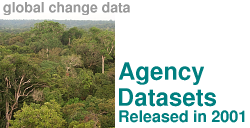global change data
Department of Energy Releases Updated Greenhouse Gas Database
The U.S. Department of Energy's Carbon Dioxide Information Analysis Center
(CDIAC) has released an updated data base from the global ALE/GAGE/AGAGE
monitoring network (DB1001), which provides continuous high-frequency
measurements of methane, nitrous oxide, several halogenated hydrocarbons,
carbon monoxide, and hydrogen. This data base supports analyses and
monitoring related to greenhouse gases and to the Earth's ozone layer.
The data were contributed by R. Prinn, Massachusetts Institute of
Technology; D. Cunnold, Georgia Institute of Technology; P. Fraser,
Commonwealth Scientific and Industrial Research Organization (CSIRO,
Australia); R. Weiss, Scripps Institution of Oceanography (SIO);
P. Simmonds and S. O'Doherty, Bristol University (United Kingdom);
L.P. Steele (CSIRO); P. Salameh, SIO; and R.H.J. Wang, Georgia Institute
of Technology. Data through March 2003 are now available for all five
existing sites: Cape Grim, Tasmania; Point Matatula, American Samoa;
Ragged Point, Barbados; Mace Head, Ireland; and Trinidad Head, California
(stations also previously existed at Cape Meares, Oregon, and Adrigole,
Ireland).
U.S. Department of Energy Carbon Dioxide
Information Analysis Center (CDIAC). Data available here.
global change data
Estimates of CO2 Emissions Released by Dept. of Energy's CDIAC
The U.S. Department of Energy's Carbon Dioxide Information Analysis
Center (CDIAC) has released estimates of CO2
emissions from fossil-fuel combustion and cement production, on global,
regional, and national scales, for the years 1751-2000. The estimate for
2000 global CO2 emissions, 6611 million metric
tons of carbon, represents a 1.8% increase from 1999. These estimates,
derived primarily from energy statistics published by the United Nations,
were calculated using the methods of Marland and Rotty (1984). Cement
production estimates from the U.S. Department of Interior's Bureau of
Mines were used to estimate CO2 emitted during
cement production. Emissions from gas flaring were derived primarily from
U.N. data, and were supplemented with data from the U.S. Department of
Energy's Energy Information Administration (EIA) and CDIAC.
U.S. Department of Energy (DOE), Carbon Dioxide
Information Analysis Center (CDIAC). Data available here.
global change data
Landsat 7 Continues To Provide Earth Science Data
Landsat 7, one of the Nation's two earth remote sensing satellites,
continues to provide useful images and data of the earth's surface
despite a problem encountered with one part of the satellite. Attempts
to fix the problem from earth have not been successful. "The problem
involves a correction for the forward motion of the satellite," said
R.J. Thompson, chief of the U.S. Geological Survey's EROS Data Center,
from where the Landsat Program is managed. "But Landsat 7 continues to
operate and send back degraded but still useful images and data that
earth scientists use to track changes in the surface of our planet."
Thompson said Landsat 7 is acquiring about 75 percent of the data of each
image it was designed to provide. In the meantime, data from Landsat 5,
launched in 1984, continues to send vital images of the U.S. and will
continue to be used as a backup and to fill in gaps in coverage areas.
Landsat 5, launched in 1984, covers the entire earth's surface every
16 days and has continually served as a backup for the technologically
advanced Landsat 7 since its 1999 launch. Landsat 5 has performed far
beyond its three-year design lifetime, and sent hundreds of thousands of
100-mile by 100-mile land-surface images to U.S. and international ground
receiving stations. The Landsat Program is the longest running program
providing vital images of the Earth's surface from space. The first
Landsat satellite was launched in 1972 and since then, Landsat satellites
have been providing a constant stream of moderate-resolution images. In
1999, the Landsat Program took a giant leap forward technologically
with the launch of Landsat 7. The instruments on the Landsat satellites
have acquired more than 4 million images of the surface of the planet,
providing a unique resource for scientists who study agriculture,
geology, forestry, regional planning, education, mapping and global
change research.
U.S. Department of the Interior, U.S. Geological
Survey (USGS). Press release available here.

The Energy Department's Atmospheric Radiation Measurement (ARM) Program
now offers CO2 flux estimates from its Southern
Great Plains (SGP) site in Oklahoma. Located on the 60 m
tower at the ARM Central Facility (CF), the flux measurement system
obtains CO2 and H2O
densities using an infrared gas analyzer, and wind speed and direction and
virtual temperature using a sonic anemometer. From these measurements,
half hour to four hour mean flux estimates are calculated at 2, 4, 25,
and 60 m above the ground. The concentrations and flux estimates
from the continuous monitoring at the SGP site are available at the
ARM Archive.
U.S. Department of Energy, Atmospheric Radiation
Measurement (ARM) Program. Data available here.

Dataset database now searchable on the web
This catalog provides
a comprehensive list of global change-related data sets made
available during 2001 from federal agencies. The fifth in a series
of yearly publications, this catalog represents an important step in
the interagency process of making data and information from the U.S.
Global Change Research Program available to researchers, the
commercial world, policy makers, and the public. This 2001 edition is
now stored in a searchable database. To search the database, click here.
On-line editions of Newly Available Agency Data Sets That
Are Significantly Global Change Related are available
for 1997,
1998, 1999, 2000, and 2001.
U.S. Global Change Research Program, Data and
Information Working Group (DIWG). Original document available here. Searchable database
available here.

